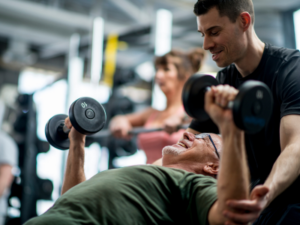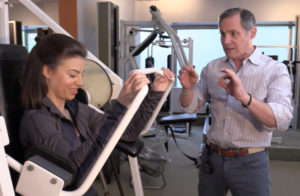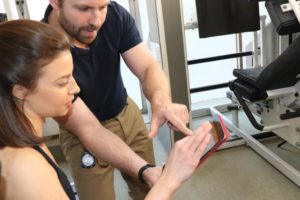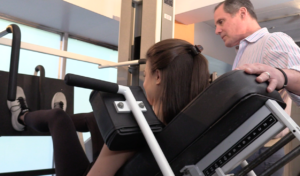![]()
Hilarious, New York Times best-selling author of The Year of Living Biblically and The Know-it-All, A. J. Jacobs documents his hands-on attempts at utterly quixotic tasks and then lives to write about them. Jacobs records in Drop Dead Healthy, “one man’s humble quest for bodily perfection,” as he indiscriminately subjects himself to countless workouts, diets, devices, and health advice, some bordering on the absurd.
An extremely engaging writer (and editor for Esquire magazine), Jacobs weaves his “maximum health” experiences – reporting what practices he learns, implements and adopts – around stories about his extended family, including his long-suffering wife, Julie.
Although most health advice can be summed up with ‘eat less, move more, and relax’ just a few of the more-entertaining highlights of Jacobs’ quest to being as healthy as possible are:
- using a treadmill desk, because prolonged sitting is bad for our health;
- carrying his own small plate and mini utensils, because eating slowly encourages us to consume less;
- making liberal use of cayenne pepper, because spicy foods decrease hunger;
- wearing noise-cancelling headphones several hours a day, because noise affects our stress levels; and
- squatting in the bathroom, because sitting puts too much pressure on the bowels.
Included in this literary, real-life adventure is Jacobs’ visit to InForm Fitness NYC and his brush with the Power-of-10 ultimate workout. Jacobs’ recount of the initial consultation and his proceeding workout include quoting me as saying:
“When we look back, I believe we will know Jane Fonda and her ilk as the people who destroyed America’s knees….Why would you spend six to twelve hours on cardio, when you can get the same exact thing in twenty minutes a week?”
“Your goal is to reach muscle failure. You’ll be out of this freakin’ torturous machine in a minute and a half.”
After a few workouts, Jacobs decides, in defeat, that he’d “have to continue cardio” and moves on to explore dozens of other workouts. Above all others, however, Jacobs implements and adopts HIIT – what he coined the “aerobic cousin of the slow-cadence weights workout [he] did with Adam Zickerman” – and claims there are more studies with empirical evidence to back it up.
Jacobs was referring to High-Intensity Interval Training (HIIT), where instead of jogging at 60% of your ability for 45 minutes, for example, you sprint at 100% of your ability for a mere 30 seconds. The workout cycles through sprint, stop, rest and repeat, for a reduced total period of say 12 minutes.
It is my opinion that while Jacobs’ observation that HIIT has more supporting empirical evidence may be true, why I suggested in the title that he Got It Wrong is because I believe his conclusion that HIIT has more merit than resistance exercise, such as in the Power of 10, is misguided. And this is not aimed at Jacobs alone – millions of people misinterpret this.
Jacobs did not make the connection that the studies he refers to support that the results were from the level of intensity of the exercise and not the means, which in turn supports the Power of 10 program. While both the Power-of-10 and HIIT require efforts being dialed up to “10” to achieve the maximum gains in the minimal times recorded – the common denominator between the two workouts’ correlated success is the shared intensity level. Intensity is the key to stimulating our bodies to produce the adaptive responses we desire.
Your muscles don’t know if you are on a bicycle or on a weight machine, it knows only the energy requirements being demanded – and then responds accordingly. High-intensity exertion, whether performed on an aerobic machine such as the treadmill, or a weight machine such as a leg press, ignites the same metabolic response to our body’s energy systems. The harder and more intensely your muscles are made to work, the harder and more intensely the energy systems that support them are made to work. This is the stimulus that brings about the results!
Intense resistance exercise, is in fact scientifically supported. On May 23, 2007 researchers Simon Melov et al, concluded that healthy older adults showed evidence of mitochondrial impairment and muscle weakness being partially reversed at the phenotypic level, and substantially reversed at the transcriptome level, following six months of resistance exercise training. Virtually discovering a ‘fountain of youth’ they stated, “The important and novel finding is that resistance exercise training reverses many aspects of the aging transcriptome signature. This implies that a functional improvement in aging muscle due to resistance exercise is associated with a global improvement in the molecular signature of aging particularly for transcripts related to mitochondrial function.”
So to my point, and the point of the Power of 10 program, I call upon McMaster University professor (and a leading HIIT proponent) Martin Gibala’s analogy to the Band-Aid Removal Preference Dilemma: Would you rather rip the band aid off quickly and endure a relatively brief flash of intense pain, or pull it off slowly, dragging on the slighter pain for much longer?
The time commitment to even attempt to achieve the same results of a Power-of-10 or HIIT workout with steady-state activity is staggering and that’s not even saying it’s possible! So, I repeat my challenge — why would anyone waste six to twelve hours a week on cardio when they can achieve results more safely and efficiently with 20 minutes once a week?
![]()









